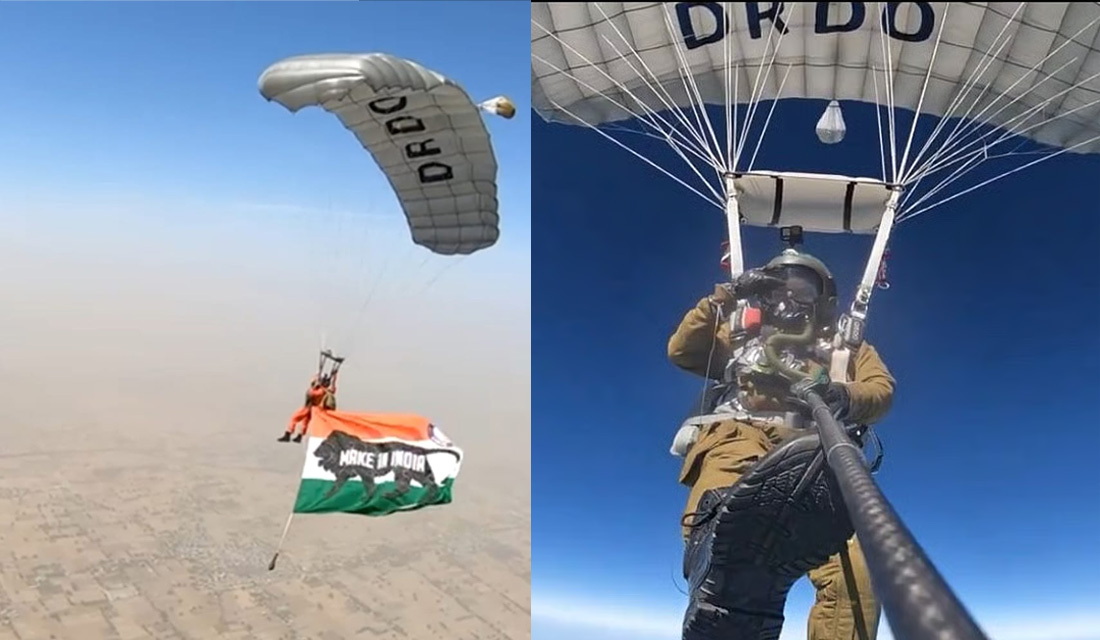India Air Force successfully tests indigenously developed Military Combat Parachute System: Read its main features and how it will enhance India’s defence capabilities
Marking a major feat in indigenous defence technologies, the Indian Air Force successfully tested an indigenous parachute system developed by the Defence Research and Development Organisation (DRDO) on Wednesday (15th October). Indian Air Force personnel, Wing Commander Vishal Lakhes, VM(G) and Master Warrant Officers R J Singh and Vivek Tiwari, tested the Military Combat Parachute System (MCPS) by conducting a free-fall jump from 32,000 feet, making it the only currently operational parachute system capable of deployment above 25,000 feet. This is a significant improvement over its earlier test trial in March 2025, when it was successfully tested for a free-fall jump from an altitude of 27,000 feet. In both test trials, the MCPS system displayed unparalleled reliability and efficiency. Developed by DRDO’s Aerial Delivery Research and Development Establishment (ADRDE), Agra, and Defence Bioengineering and Electromedical Laboratory (DEBEL), Bengaluru, the MCPS significantly enhances the operational abilities of the Indian Air Force for modern airborne operations. High-altitude parachute systems are crucial for conducting operations in challenging terrain like mountainous regions and contested territories. They provide a leverage to special forces and airborne units engaged in operations in areas where conventional deployment is not possible. The MCPS has specifically been designed for difficult, high-altitude airborne operations to allow paratroopers to descend by evading enemy radars and air defence systems and cover large distances. This is a robust and reliable parachute system, developed with inputs from operational units and equipped to handle challenges like extreme heights, low oxygen levels, extremely low temperatures and strong winds. The system will prove immensely useful in covert insertions, rapid troop deployment and disaster response in high-altitude or mountaineous areas like the Himalayas. It offers a range of enhanced tactical features, which are not available in any of the existing parachute systems used by the Indian Defence Forces. Key features of the MCPS and how it will improve IAF’s operational capabilities Lower Rate of Descent: Compared to existing parachute systems, the MCPS has been engineered to have a lower rate of descent. Reduced speed of descent will lower the risk of injury while landing and allow paratroopers to descend safely with a heavy combat load. This will improve survivability during descent in challenging terrains. Increased Steering capabilities: The Military Combat Parachute System embodies advanced steering mechanisms, which offer improved steering control, allowing paratroopers finer lateral control and to navigate with enhanced precision. This also enhances the paratroopers’ ability to adjust their flight path in the air, dodge obstacles and land with accuracy even amid extreme weather conditions. High-altitude deployment: This feature of the MCPS is critical for operations requiring long-range infiltration or covert operations. The deployment ability of 32,000 feet is unique to this parachute system, as the existing traditional systems lack this. This makes the system preferable for High-Altitude Low-Opening (HALO) and High-Altitude High-Opening (HAHO) style operations. HALO and HAHO are advanced military parachuting techniques used for covert insertions into hostile territory from altitudes ranging from 15,000 feet to 35,000 feet. HALO jump involves opening the parachute at a lower altitude after a period of free-fall, while in HAHO jump, the parachute is opened at a high altitude shortly after exiting the aircraft. The MCPS reduces the exposure to hostile air defences by allowing paratroopers to jump outside the reach of many air defences and extending the time for navigation and formation before descent. NaVIC compatibility: Compatibility with India’s indigenous satellite navigation system NavIC (Navigation with Indian Constellation) is another unique feature of the MCPS. The feature has been incorporated in the system as the DRDO and the Ministry of Defence (MoD) wanted to ensure that the MCPS is not dependent on third-party global navigation satellite systems (GNSS) to avoid the possibility of jamming or denial of access during times of conflict. GNSS resilience is a way to reduce the risk of an adversary blocking or degrading the navigation for airborne forces, which would affect their capability for precise insertion and hinder the operations in electronic warfare environments. Thus, the NavIC compatibility of the MCPS system would ensure autonomy during military operations and block the interference of foreign actors. Combat Load compatibility: The MCPS allows paratroopers to carry a full combat load. This means paratroopers engaged in airborne operations would be able to carry all necessary equipment, including weapons, communication devices and survival gear, without compromising their safety or efficiency during the opera



Marking a major feat in indigenous defence technologies, the Indian Air Force successfully tested an indigenous parachute system developed by the Defence Research and Development Organisation (DRDO) on Wednesday (15th October). Indian Air Force personnel, Wing Commander Vishal Lakhes, VM(G) and Master Warrant Officers R J Singh and Vivek Tiwari, tested the Military Combat Parachute System (MCPS) by conducting a free-fall jump from 32,000 feet, making it the only currently operational parachute system capable of deployment above 25,000 feet.
This is a significant improvement over its earlier test trial in March 2025, when it was successfully tested for a free-fall jump from an altitude of 27,000 feet. In both test trials, the MCPS system displayed unparalleled reliability and efficiency.
Developed by DRDO’s Aerial Delivery Research and Development Establishment (ADRDE), Agra, and Defence Bioengineering and Electromedical Laboratory (DEBEL), Bengaluru, the MCPS significantly enhances the operational abilities of the Indian Air Force for modern airborne operations. High-altitude parachute systems are crucial for conducting operations in challenging terrain like mountainous regions and contested territories. They provide a leverage to special forces and airborne units engaged in operations in areas where conventional deployment is not possible. The MCPS has specifically been designed for difficult, high-altitude airborne operations to allow paratroopers to descend by evading enemy radars and air defence systems and cover large distances.
This is a robust and reliable parachute system, developed with inputs from operational units and equipped to handle challenges like extreme heights, low oxygen levels, extremely low temperatures and strong winds. The system will prove immensely useful in covert insertions, rapid troop deployment and disaster response in high-altitude or mountaineous areas like the Himalayas. It offers a range of enhanced tactical features, which are not available in any of the existing parachute systems used by the Indian Defence Forces.
Key features of the MCPS and how it will improve IAF’s operational capabilities
Lower Rate of Descent: Compared to existing parachute systems, the MCPS has been engineered to have a lower rate of descent. Reduced speed of descent will lower the risk of injury while landing and allow paratroopers to descend safely with a heavy combat load. This will improve survivability during descent in challenging terrains.
Increased Steering capabilities: The Military Combat Parachute System embodies advanced steering mechanisms, which offer improved steering control, allowing paratroopers finer lateral control and to navigate with enhanced precision. This also enhances the paratroopers’ ability to adjust their flight path in the air, dodge obstacles and land with accuracy even amid extreme weather conditions.
High-altitude deployment: This feature of the MCPS is critical for operations requiring long-range infiltration or covert operations. The deployment ability of 32,000 feet is unique to this parachute system, as the existing traditional systems lack this. This makes the system preferable for High-Altitude Low-Opening (HALO) and High-Altitude High-Opening (HAHO) style operations. HALO and HAHO are advanced military parachuting techniques used for covert insertions into hostile territory from altitudes ranging from 15,000 feet to 35,000 feet. HALO jump involves opening the parachute at a lower altitude after a period of free-fall, while in HAHO jump, the parachute is opened at a high altitude shortly after exiting the aircraft. The MCPS reduces the exposure to hostile air defences by allowing paratroopers to jump outside the reach of many air defences and extending the time for navigation and formation before descent.
NaVIC compatibility: Compatibility with India’s indigenous satellite navigation system NavIC (Navigation with Indian Constellation) is another unique feature of the MCPS. The feature has been incorporated in the system as the DRDO and the Ministry of Defence (MoD) wanted to ensure that the MCPS is not dependent on third-party global navigation satellite systems (GNSS) to avoid the possibility of jamming or denial of access during times of conflict. GNSS resilience is a way to reduce the risk of an adversary blocking or degrading the navigation for airborne forces, which would affect their capability for precise insertion and hinder the operations in electronic warfare environments. Thus, the NavIC compatibility of the MCPS system would ensure autonomy during military operations and block the interference of foreign actors.
Combat Load compatibility: The MCPS allows paratroopers to carry a full combat load. This means paratroopers engaged in airborne operations would be able to carry all necessary equipment, including weapons, communication devices and survival gear, without compromising their safety or efficiency during the operation.
Indigenous manufacturing and maintenance: Since the MCPS is indigenously designed and maintained, it will significantly reduce the turnaround time for maintenance or repair. This will also reduce dependency on imported parachute systems procured from foreign suppliers and improve availability, especially during prolonged operations.
The development marks a tactical enhancement in India’s defence capabilities and an advancement in the country’s self-reliance in the field of defence technologies. This is also a significant step towards equipping Indian security personnel with modern defence and warfare technology using indigenous innovations, and gradually reducing India’s dependence on other nations.




































































